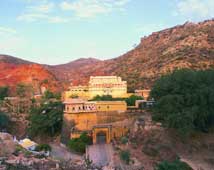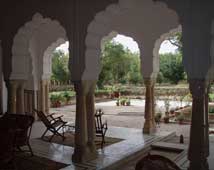
Samode is situated in the royal Indian state of Rajasthan around 42 km from capital city Jaipur. This small village is famous for its haveli and fort. Samode was one of the princely place of Jaipur. It was built in the 19th century. The highlighting of the building is the exquisite Diwan-i-khas covered with original paintings and mirror work.
Its an ideal spot for outings and for picnics. Samode is famous for Samode Palace and Samode Bagh. The Nathawats of Samode played an important role in the durbar of Jaipur. Samode is an ideal desert gateway. During the day a camel ride through the Samode village and the surroundings countryside is a good side.
History of Samode
Samode according to Rajputana it was a large town. The landlords of Samode the principal thakurs of the state of Amber were the Nathawat tracing their relation to Prithviraj Singhji. One of his son Gopalji was awarded Samode a noble feudatory of the Amber and Jaipur principality. It was among the wealthiest territories in the Amber kingdom. In1757 the territory was returned to Nathawats. For the first half existence of this palace was a little more than a fortified stronghold in the rugged Rajput tradition.
In 19th century under Rawal did the castle begin to take on the lavish aspects. He reached distinction as the principal signatory of the historic 1818 treaty making Jaipur a protectorate of British East India Company. then Samode Palace was transformed in to an one of the country's premium palace hotel in 1987. It was showing a perfect example of Rajput mughal architecture and built on small hillock and planned in a progression of courtyards of increasing height. Its a touching reminder of the vision of its creators.
Samode has a very high temperature. The summers are very hot shooting up to 45° C, on the other hand winters are chilly and temperature go down to 5° C. The best time to visit Samode is the period between October to March.
Samode Bagh
Samode Bagh was built by Rawal Sheo Singhji. It is modelled on the geometric style of the Mughal Garden. Visitors came here to enjoy rare moments in airy atmosphere, which is surrounded by rippling water fountains. Special feature of the stay here is the accommodation which is provided in the tents. the central point of the bagh is meeting point which is elegantly furnished Durbar tent. Evening come alive with the local folk music and dances in the magic of camp fire. Many entertainment activities available here include camel safaries. a visit to the village and Samode Palace.

Samode Palace
The Samode Palace displays the excellence of Rajasthani architecture. It is built in that pattern of an open courtyard with rooms leading off the arched corridor that runs along all the four sides of building. the painstakingly carved Sultan Mahal reflects an artists Zest for creativity and excellence. Durbaar Hall is painted with Ornate floral motifis and colored delicately with vegetable pigments carries a charm of its own.
Sultan Mahal
The Sultan Mahal is on the first floor-an exquisite room with a marble pillared verandah. It has the famous Jaipur blue tile decorations. Every inch of the ceiling and the walls are covered with floral, paisley and geometric motifs painted in vegetable colors. It is called Sultan Mahal after the craftsman, who painstakingly created it. Old and heavy carved silver furniture brought from Nepal by the grandmother of the present Rawal gleam dully in sunlight even today.
Hall of Mirrors
The splendid hall of mirror is another attraction that will leave anyone spellbound. Large and tiny fragments of polished mirror are set into the plaster work and reflects a thousand images of the person entering the room.